
The Solar-Terrestrial Centre of Excellence (STCE) is a collaborative network of the Belgian Institute for Space Aeronomy, the Royal Observatory of Belgium and the Royal Meteorological Institute of Belgium.
 |
Published by the STCE - this issue : 27 Feb 2015. The Solar-Terrestrial Centre of Excellence (STCE) is a collaborative network of the Belgian Institute for Space Aeronomy, the Royal Observatory of Belgium and the Royal Meteorological Institute of Belgium. |
| Archive of the newsletters | Subscribe to this newsletter by mail |
After the M2 flare on 9 February, the Sun decided to take a break, with only low-level C-class flares during the subsequent two weeks. In fact, for 5 consecutive days (from 13 till 17 February), not even a C-class flare was registered, as can be seen in graph underneath.
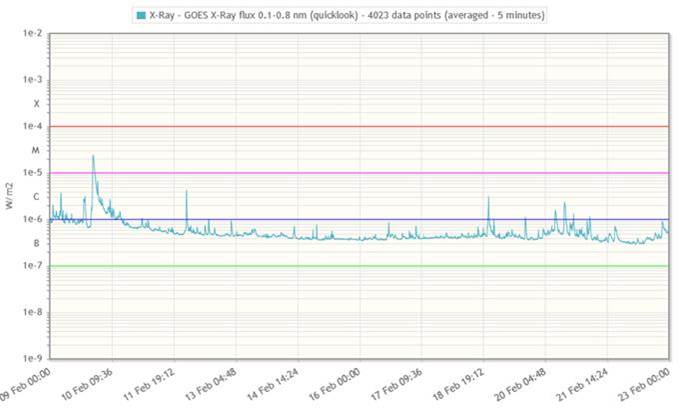
So, there seemed to be very little of interest to write about, but fortunately the folks at SOHO alerted the community of a tiny comet passing through the field of view of SOHO's coronagraphs, see their pick of the week at http://sohowww.nascom.nasa.gov/pickoftheweek/old/20feb2015/). A coronagraph is an instrument that blocks out the solar disk so that the immediate vicinity around the Sun becomes visible, similar to what our Moon does during a total solar eclipse. Though SOHO's coronagraph is used to observe coronal mass ejections (CME), it has also made SOHO the most successful comet hunter so far. Indeed, the newly found dot is the 2875th comet on SOHO's very long list of comet discoveries. Quite a few of those were actually made by amateur astronomers who were examining SOHO's imagery.
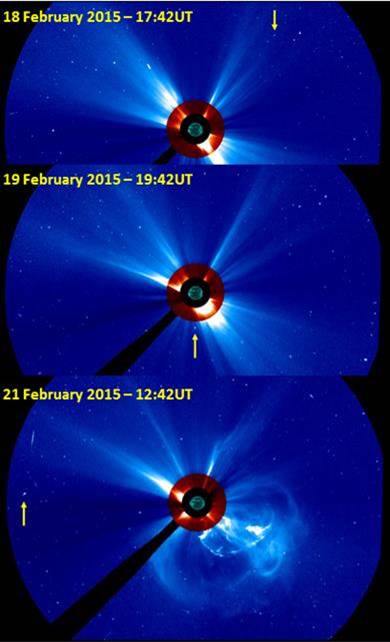
As the comet SOHO-2875 was approaching the Sun, it appeared as a fast-moving star-like object on 18 February (see image above on top). It could hardly be distinguished from the starry background, except for its motion of course. Scientists were not expecting much of this ball of ice and dust, until the comet all of a sudden started to display a tiny tail after its swing-by of the Sun. Astronomers are now eagerly awaiting its appearance in the evening sky to see if it can be observed by telescope.
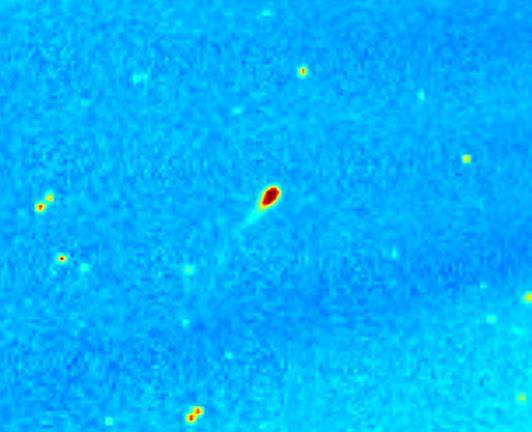
What seems already certain is that -unlike most of the comets discovered by SOHO- this one does not belong to the Kreutz group. This is a group of comets that all follow pretty much the same orbit that brings them very close to the Sun ("sungrazers"). It is believed that they are all fragments of a comet that broke apart several centuries ago. Most of the Kreutz members do not survive their kiss and ride with the Sun, comet Lovejoy (2011) being a notable exception (see sketch of orbit below). That SOHO-2875 does not belong to the Kreutz group is apparent from its motion. The Kreutz members all pass most of their orbit below the ecliptic (the plane created by the yearly movement of the Earth around the Sun), which make them also rather insensitive to gravitational perturbations from the planets. Only during their close encounter with the Sun do they briefly stay above the ecliptic. The completely different orbits can be seen in this movie at http://youtu.be/YvIs-jEiv2c where the motion of SOHO-2875 is compared to that of comet Lovejoy.
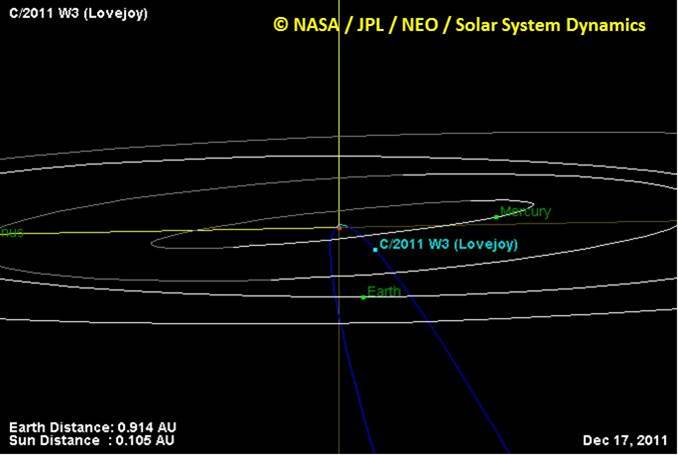
SOHO-2875 seems also to have been just in time to avoid being hit by 2 CMEs. In particular the second CME on 21 February was quite strong and speedy (average plane-of-the-sky speed of about 900 km/s). It originated from the backside of the Sun and concerned the eruption of the very long filament that was visible from Earth just 2 weeks ago, as discussed in this news item at http://stce.be/news/294/welcome.html The image underneath (as well as in the movie) is a false color clip showing the comet to the left and the CME from the filament eruption expanding to the lower right. The CME did not have an Earth directed component.
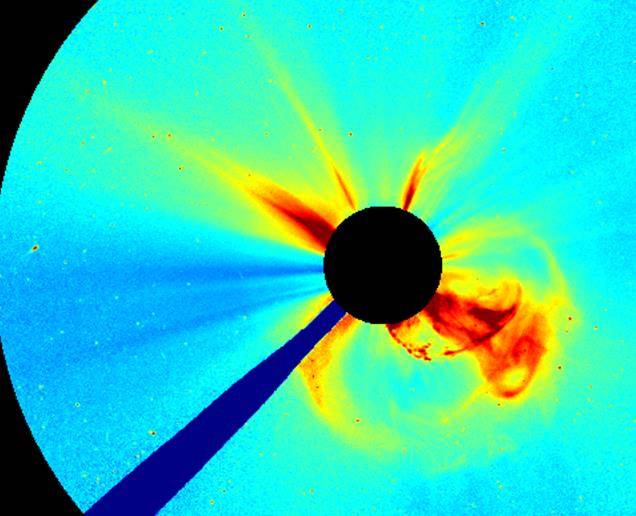
Credits - Images for the movies were taken from SOHO (http://sohowww.nascom.nasa.gov/home.html), SDO (http://sdo.gsfc.nasa.gov/data/aiahmi/), NASA/JPL/NEO/Solar System Dynamics (http://neo.jpl.nasa.gov/orbits/), and (J)Helioviewer (http://helioviewer.org/).
Solar flare activity fluctuated between very low and low during the week.
In order to view the activity of this week in more detail, we suggest to go to the following website from which all the daily (normal and difference) movies can be accessed:http://proba2.oma.be/ssa
This page also lists the recorded flaring events.
A weekly overview movie can be found here (SWAP week 256).
http://proba2.oma.be/swap/data/mpg/movies/weekly_movies/weekly_movie_2015_02_16.mp4
Details about some of this week’s events, can be found further below.
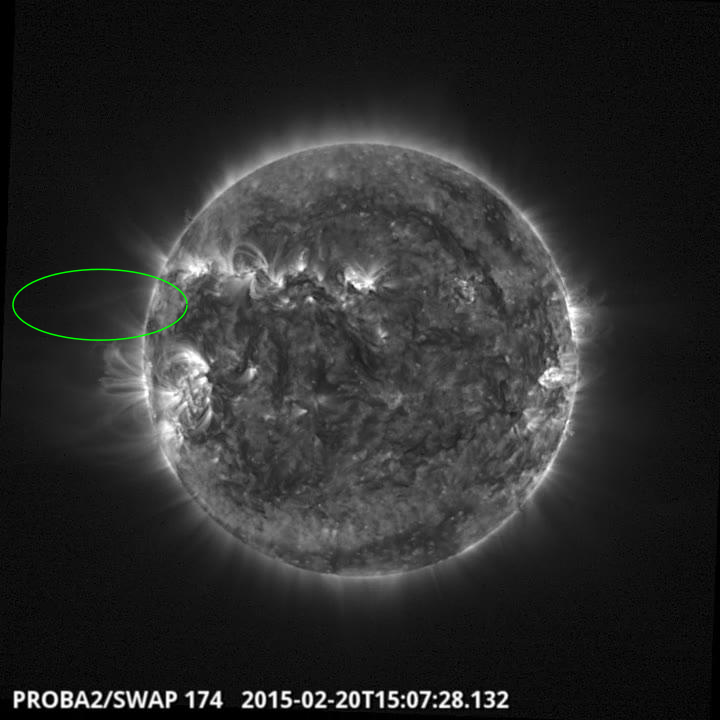
Eruption on the east limb @ 15:07 SWAP image
Find a movie of the event here (SWAP movie)
http://proba2.oma.be/swap/data/mpg/movies/20150220_swap_movie.mp4
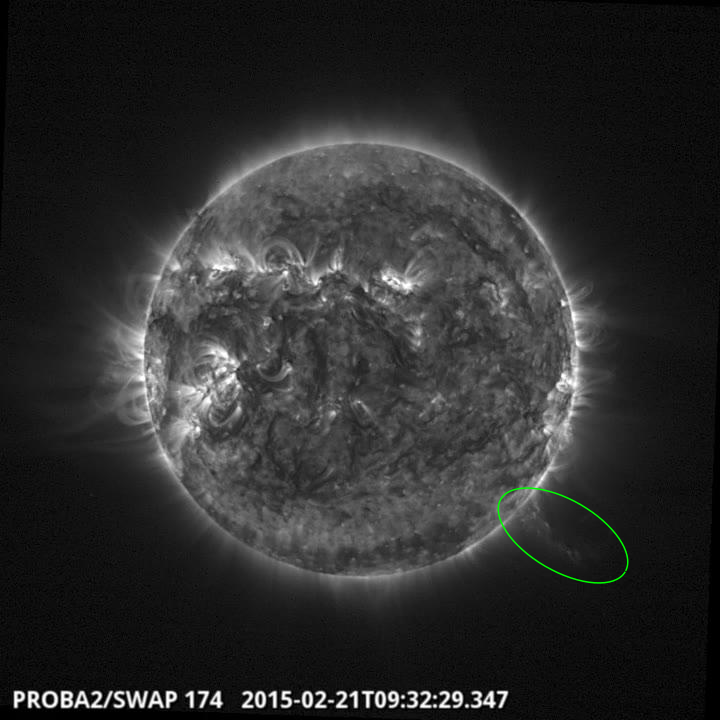
Eruption on the west limb @ 09:32 SWAP image
Find a movie of the event here (SWAP movie)
http://proba2.oma.be/swap/data/mpg/movies/20150221_swap_movie.mp4
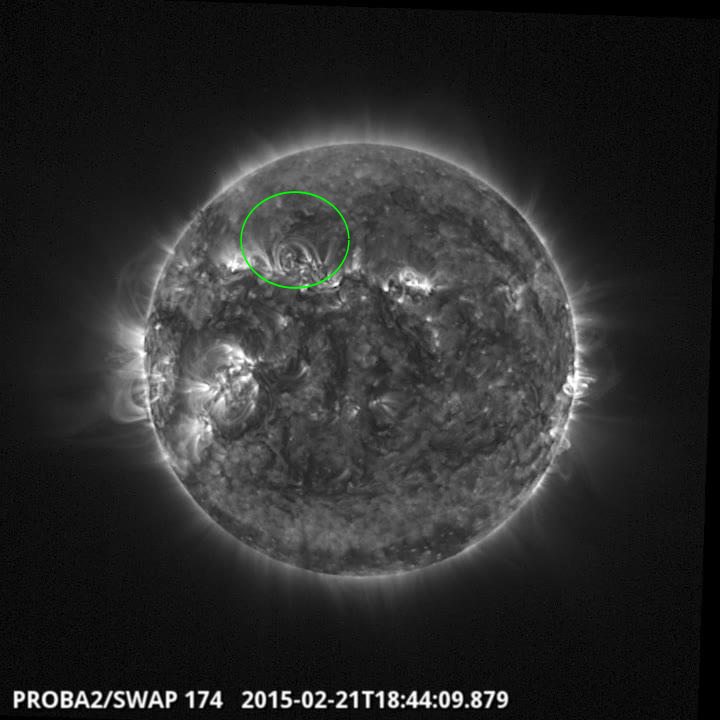
Eruption on the west limb @ 18:44 SWAP image
Find a movie of the event here (SWAP movie)
http://proba2.oma.be/swap/data/mpg/movies/20150221_swap_movie.mp4
Solar activity was very low to low throughout the week. The background level of the X-ray flux was at B-level as can be seen in the graph below where the GOES X-ray flux 0.1-0.8 nm is plotted from Feb 16 to 22.
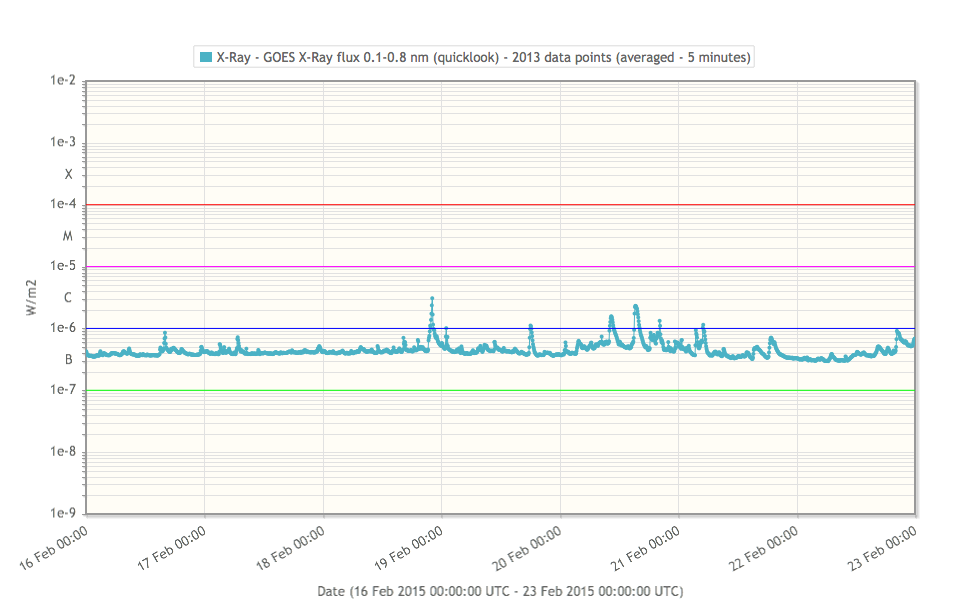
Only nine lower C-class flares and a bunch of B-class flares were produced. The largest activity originated from NOAA active regions (ARs) 2282 and 2286, with a C2.3 flare as strongest Xray event (peak at 15:22 UT on February 20). NOAA ARs 2287, 2289 and 2290 only produced some tiny flaring.
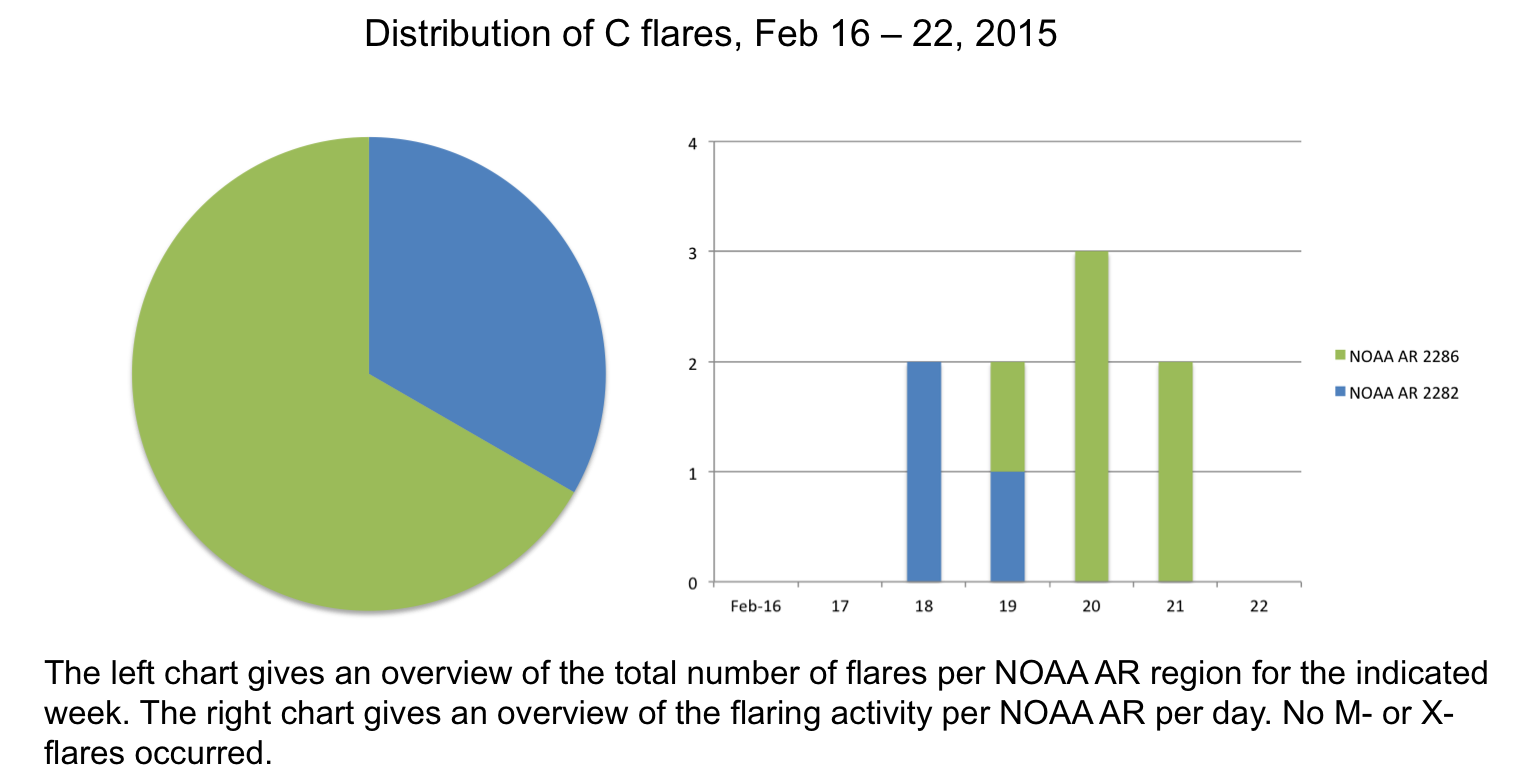
An asymmetric halo CME was detected in coronagraphic imagery (first measurement in SOHO LASCO/C2 at 9:24 UT on February 21), associated to a backside eruption of a large filament in the southern hemisphere that was present for more than one and a half of a solar rotation.
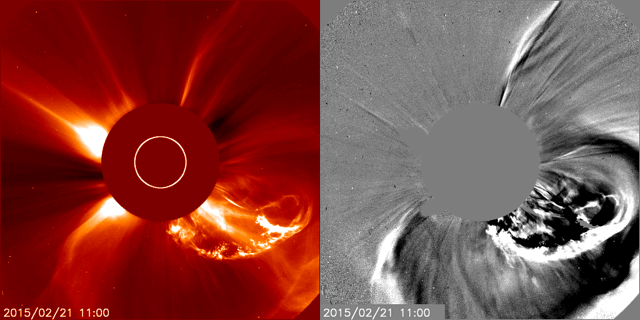
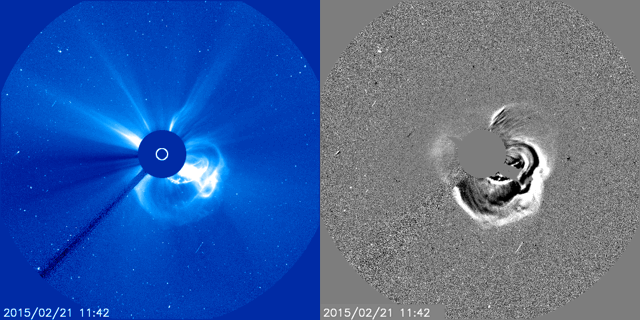
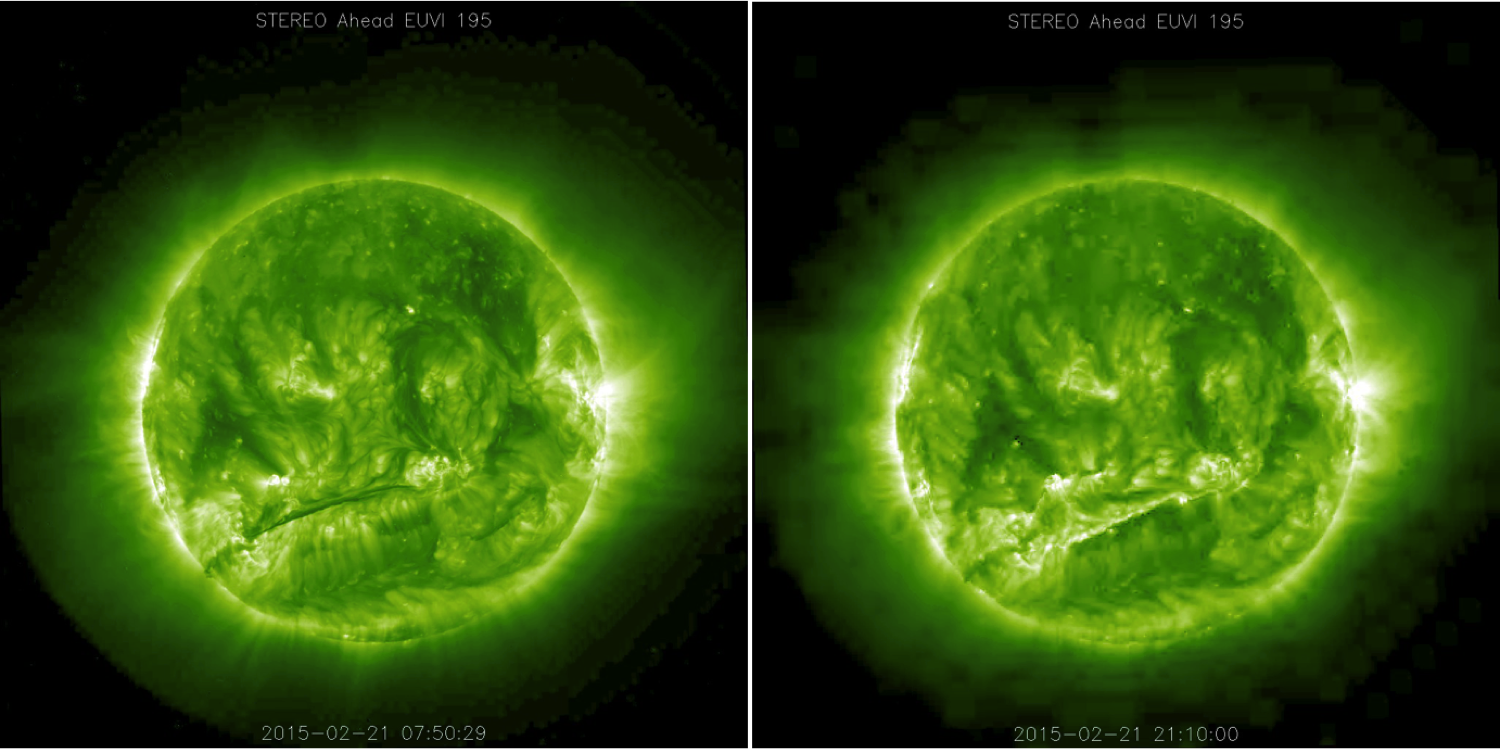
The red and blue image are taken by the coronagraph LASCO onboard SOHO. The grey images are difference images and show what changed between the two subtracted images. Difference images help to see changes. The green images are taken by the STEREO A spacecraft and show the back side of the Sun. You see the large erupting filament (left) and the post-eruption loops (right) .
The CME was mainly heading to the southwest with an estimated projected speed of approximately 1000 km/s. The proton flux (at > 10 MeV energy levels) has risen to enhanced levels starting around 12 UT, but did not pass the event threshold.
A filament eruption was visible in EUV imagery starting in PROBA2/SWAP at 18:09 UT on February 21, accompanied by a long-duration B7 flare.
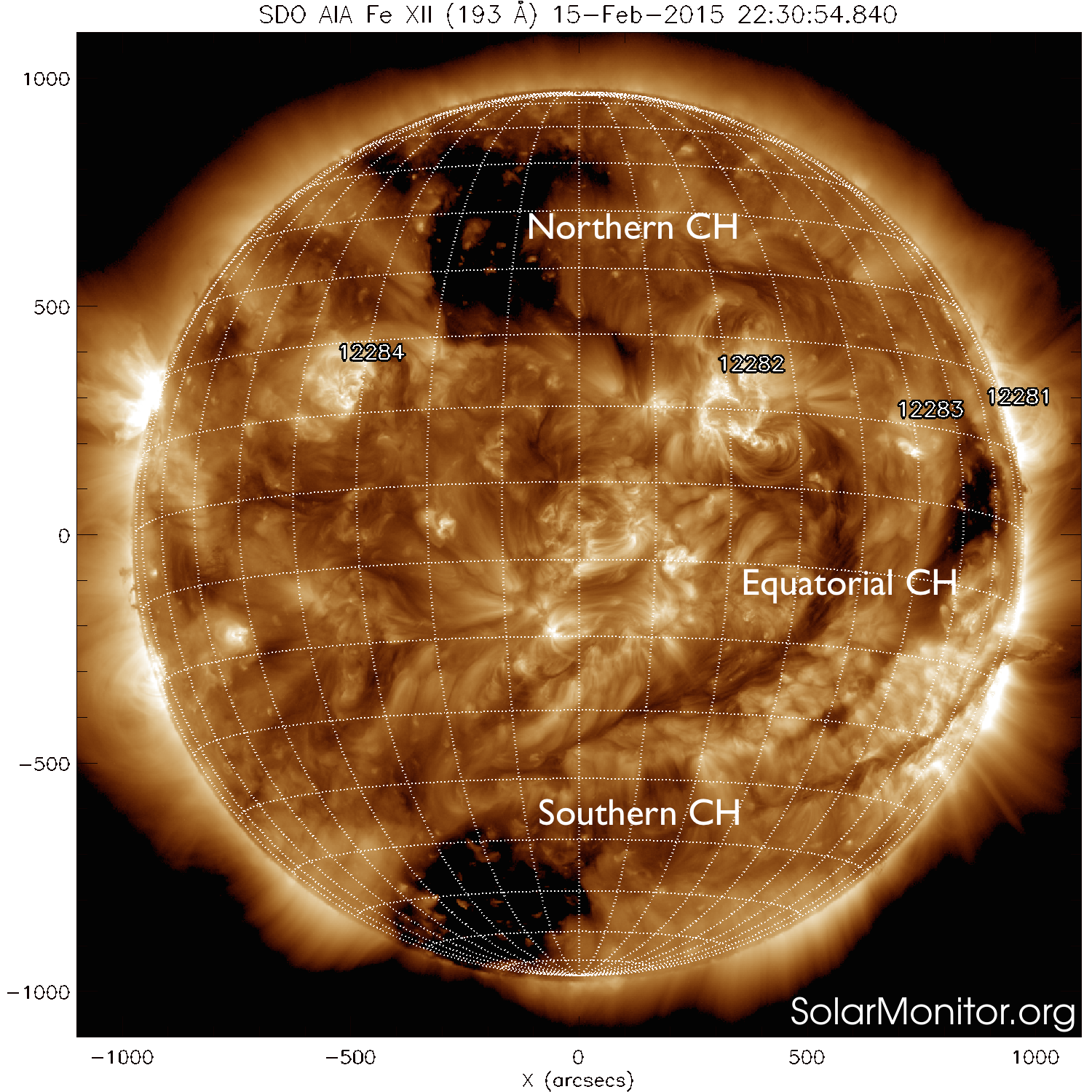
For most of the week Earth was facing nominal solar wind conditions with an interplanetary magnetic field magnitude below 10 nT. During the period between 12:00 UT on February 16 and 8:00 UT on February 17, the IMF magnitude was slightly enhanced to maximally 16 nT. Solar wind speed was mostly between 300 and 400 km/s, except for the period from early February 17 till the second half of February 19 on during which a maximum of about 480 km/s was reached.
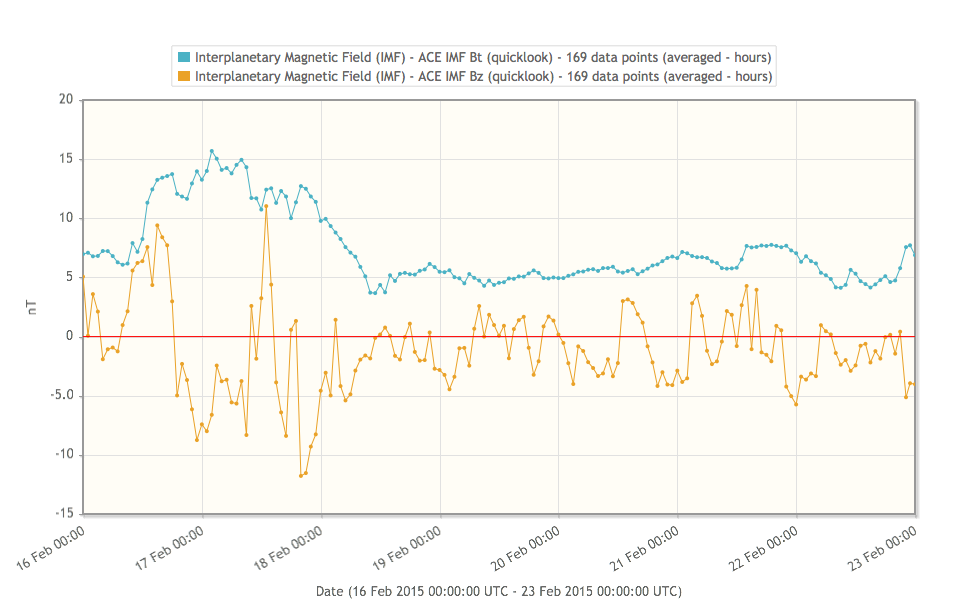
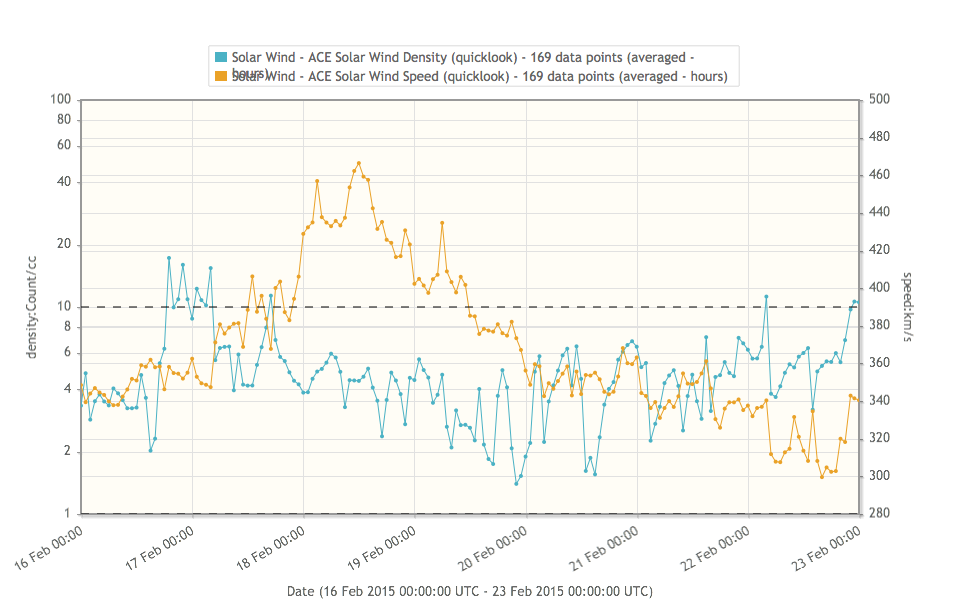
The disturbed solar wind conditions (magnetic field and solar wind speed) starting on February 16 are associated to the influence of a compression region followed by a solar wind stream from the equatorial negative polarity CH. Geomagnetic conditions were unsettled to active (K=3 to 4) during several time slots from 18 UT on February 16 to 12 UT on February 18. Quiet to unsettled geomagnetic conditions were observed during the remainder of the week.
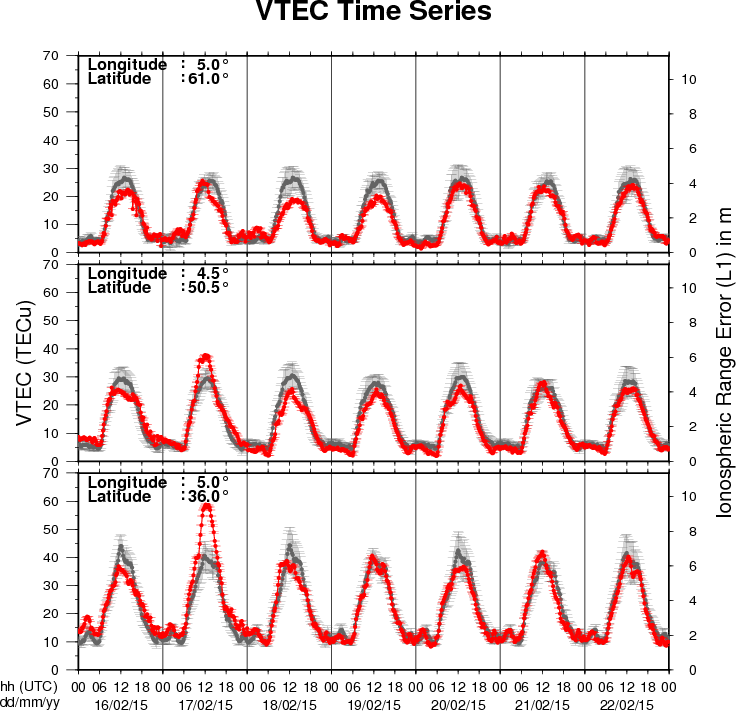
The figure shows the time evolution of the Vertical Total Electron Content (VTEC) (in red) during the last week at three locations:
a) in the northern part of Europe(N61°, 5°E)
b) above Brussels(N50.5°, 4.5°E)
c) in the southern part of Europe(N36°, 5°E)
This figure also shows (in grey) the normal ionospheric behaviour expected based on the median VTEC from the 15 previous days.
The VTEC is expressed in TECu (with TECu=10^16 electrons per square meter) and is directly related to the signal propagation delay due to the ionosphere (in figure: delay on GPS L1 frequency).
The Sun's radiation ionizes the Earth's upper atmosphere, the ionosphere, located from about 60km to 1000km above the Earth's surface.The ionization process in the ionosphere produces ions and free electrons. These electrons perturb the propagation of the GNSS (Global Navigation Satellite System) signals by inducing a so-called ionospheric delay.
See http://stce.be/newsletter/GNSS_final.pdf for some more explanations ; for detailed information, see http://gnss.be/ionosphere_tutorial.php
Start : 2015-03-16 - End : 2015-03-19
This international conference will provide an overview of our
current understanding of Sun-Climate Connections starting at
processes on the Sun itself over space weather and solar wind
towards solar influence on the upper atmosphere down to the ocean.
It will also provide insights into the heatedly debated role of the
Sun in climate change. In four sessions the various contributions
of solar variability influence on Earth's climate will be presented
and discussed by bringing together solar physicists, space
scientists, atmospheric scientists, climate modellers, and
paleoclimatologists.
We expect contributions from scientists participating in
SCOSTEP/ROSMIC, SPARC-SOLARIS/HEPPA, the EU cost network TOSCA, as
well as any other interested scientists. The conference will last
three full days, beginning Monday morning, 16 March 2013. The
programme will consist of invited and keynote lectures, a few
contributed oral presentations and ample time dedicated to poster
sessions. The fourth day will be devoted to public outreach
activities as well as panel discussions.
Website: http://scc.geomar.de/
Start : 2015-05-18 - End : 2015-05-22
URSI AT-RASC 2015 will be the first edition of the newly
established triennial URSI Atlantic Radio Science Conference as one
of the URSI Flagship Conferences. AT-RASC 2015 will have an open
scientific program composed of submitted papers within the domains
covered by all ten Commissions of URSI.
Website: http://www.at-rasc.com/
Start : 2015-05-25 - End : 2015-05-29
25-27 May 2015: BUKS 2015 - MHD waves: Observational aspects
from ground to space - MHD waves: Theory - where are we? - MHD
instabilities
27-28 May 2015: Ruderman Honorary meeting - Theory of linear MHD
waves - MHD waves instabilities - Non-linear waves in plasmas
29 May 2015: Joint BUKS/Ruderman's conferences excursion -
Boat excursion to Szentendre, Visegrad and Esztergom
Website:
http://swat.group.shef.ac.uk/Conferences/BUKS_2015/index.html
Start : 2015-06-01 - End : 2015-07-24
The Space Weather Summer School at Los Alamos National
Laboratory, established in 2011 under the founding Director Josef
Koller, is dedicated to space weather, space science and
applications. Every year we solicit applications for the Los Alamos
Space Weather Summer School. This summer school is sponsored and
supported by a number or organizations at LANL. This year our top
sponsors include the Los Alamos Institute of Geophysics, Planetary
Physics and Signatures (IGPPS) and the Laboratory Directed Research
and Development Office (LDRD). The summer school brings together
top space science students with internationally recognized
researchers at LANL in an educational and collaborative
atmosphere.
Website:
http://www.swx-school.lanl.gov/
Start : 2015-06-09 - End : 2015-06-12
The last five years have seen substantial progress in our
understanding of the solar dynamo, fueled by continuing advances in
observations and modeling. With the launch of NASA's Solar Dynamics
Observatory (SDO) in 2010 came an unprecedented window on the
evolving magnetic topology of the Sun, highlighting its intricate
3D structure and global connectivity. The Helioseismic Magnetic
Imager (HMI) instrument on SDO in particular has provided
potentially transformative yet enigmatic insights into the internal
dynamics of the solar convection zone that underlie the dynamo.
Attempts to detect subsurface convective motions from helioseismic
inversions have yielded only upper limits on the large-scale
convective amplitude, challenging our understanding of global solar
convection. Yet, potential signatures of giant cells have been
detected in photospheric Dopplergrams. Estimates of the meridional
flow from HMI and complementary instruments (SOHO/MDI and GONG)
have been equally tantalizing and enigmatic. Several disparate
techniques, including local and global helioseismic inversions and
correlation tracking of surface features, have yielded evidence of
a multi-cellular meridional flow but they differ on the detailed
flow structure and amplitude. This multi-cellular meridional flow
has potentially profound implications for flux-transport dynamo
models that previously assumed a very different structure with a
single circulation cell per hemisphere.
Website:
https://www2.hao.ucar.edu/Workshop/Solar-Dynamo-Frontiers
Start : 2015-07-13 - End : 2015-07-24
The CISM Summer School is intended to give students a
comprehensive immersion in the subject of space weather: what it
is, what it does, and what can be done about it. Space weather is
many things: beautiful when seen through the eyes of a sun-viewing
telescope, fascinating when studied for its alien worlds of
magnetic structures and phenomena, awesome when witnessed as a
solar eruption or auroral storm, and devastating to the users of
services it disrupts. Space weather links the Sun, the Earth, and
the space in between in a branching chain of consequences. Weather
systems on the Sun can spawn interplanetary storms of colossal size
and energy that envelop the whole planet in electrical hurricanes.
Such storms attack high-tech, complex, and expensive technological
systems that provide much of the infrastructure that allows modern
society to function.
Website:
https://www2.hao.ucar.edu/Events/2015-CISM-Summer-School
Start : 2015-07-21 - End : 2015-07-23
The conference will review past and recent achievements, as well
as future challenges in the field of solar coronal loop
physics.
Website:
http://www.damtp.cam.ac.uk/user/astro/cl7/index.html
Start : 2015-07-28 - End : 2015-08-04
Heliophysics is all of the science common to the field of the
Sun-Earth connections. This fast-developing field of research
covers many traditional sub-disciplines of space physics,
astrophysics, and climate studies. The NASA Living with a Star
program, with its focus on the basic science underlying all aspects
of space weather, acts as a catalyst to bring the many research
disciplines together to deepen our understanding of the system of
systems formed by the Sun-Earth connection.
Website:
http://www.heliophysics.ucar.edu/
Start : 2015-07-30 - End : 2015-08-06
The 34th International Cosmic Ray Conference (ICRC) will be held
from July 30 to August 6, 2015, in The Hague, The Netherlands. It
is an important and large conference in the field of Astroparticle
Physics. The ICRC covers: cosmic-ray physics, solar and
heliospheric physics, gamma-ray astronomy, neutrino astronomy, and
dark matter physics.
Website: http://icrc2015.nl
Start : 2015-08-31 - End : 2015-09-04
The purpose of this conference is to discuss the latest
questions and results in solar and stellar physics. Solar and
stellar seismology will be one particular focus but contributions
on all aspects of solar-stellar relations will be welcome. We aim
to establish links and synergies between the day- and night-time
fields of astrophysics.
Website:
http://www.iac.es/congreso/solarnet-3meeting/
Start : 2015-09-02 - End : 2015-09-04
The Workshop will address how the joint exploration of the
corona and inner heliosphere will lead to advances in our
understanding of coronal heating and solar wind acceleration, the
magnetic and plasma structure of the heliosphere, and the
acceleration of energetic particles at shocks and flares. The
workshop will inspire research that will make use of SO and SPP
observations within the context of the NASA Heliophysics
Observatory System and identify key areas for preparatory research.
Synergistic observations from other ground based and space based
assets will also be addressed.
Website:
http://www.solarprobeplus.org/2015/
Start : 2015-10-05 - End : 2015-10-09
This CSPM-2015 scientific meeting will cover various aspects of
solar dynamic and magnetic phenomena which are observed over the
entire electromagnetic spectrum: white-light, Hα, Ca II,
and radio from ground and in a variety of other wavelengths (white
light, UV and EUV, and X-rays) from space. Emphasis will also be
placed on instrumentation, observing techniques, and solar image
processing techniques, as well as theory and modelling through
detailed radiative transfer in increasingly realistic MHD models.
The long-term (cyclic) evolution of solar magnetism and its
consequence for the solar atmosphere, eruptive phenomena, solar
irradiation variations, and space weather, will be in focus. Here,
special attention will be devoted to the long-term observations
made in Coimbra and also to the results of the SPRING / SOLARNET
and SCOSTEP VarSITI studies. In particular, the weak solar activity
during the current solar maximum will be discussed. Finally, since
this meeting is organised around the 90th anniversary of performing
the first spectroheliographic observations in Coimbra, a session
will be specially dedicated to new solar instruments (both
ground-based and space-borne) that will give access to unexplored
solar atmospheric features and dynamic phenomena over the coming
years.
Website:
http://www.mat.uc.pt/~cspm2015/
Start : 2015-11-10 - End : 2015-11-13
Observations of the Sun and Earth from space have revolutionized
our view and understanding about impacts of solar variability and
anthropogenic forcing on Earth climate. For more than three solar
cycles since 1978, the total and spectral solar irradiance (TSI and
SSI) and global terrestrial atmosphere/surface have been observed
continuously, enabling unprecedented quality data for Sun-climate
studies. The primary objective of this symposium is to convene
climate scientists, solar physicists, and experimentalists together
for a better understanding how Earth climate system changes and
responds to solar variability.
Website:
http://lasp.colorado.edu/home/sorce/news-events/meetings/2015-sun-climate-symposium/
Start : 2016-07-30 - End : 2016-08-07
The 41st COSPAR Scientific Assembly will be held in Istanbul,
Turkey from 30 July - 7 August 2016. This Assembly is open to all
bona fide scientists.
Website:
https://www.cospar-assembly.org/
Theoretical course on the Sun and space weather for participants to the astronomy course in Public Observatory MIRA, Grimbergen (Belgium). Given on 19 March 2014 for 35 attendees.
http://www.spaceweather.eu/en/repository/show?id=557
Presentation given during a users' visit about the STCE operational space weather services and products.
http://www.spaceweather.eu/en/repository/show?id=558
Presentation given during a users' visit about the STCE operational space weather services and products.
http://www.spaceweather.eu/en/repository/show?id=559
Presentation given during a users' visit about the STCE operational space weather services and products.
http://www.spaceweather.eu/en/repository/show?id=560
Presentation given during a users' visit about the STCE operational space weather services and products.
http://www.spaceweather.eu/en/repository/show?id=561
Presentation given during a users' visit about the STCE operational space weather services and products.
http://www.spaceweather.eu/en/repository/show?id=562
Presentation given during a users' visit about the STCE operational space weather services and products.
http://www.spaceweather.eu/en/repository/show?id=563
Invited review submitted to the journal Revue E. This article is the first in a series of 3 articles.
De Zon, Helios, Sol, ... er bestaan vele namen voor die gele bol die dagelijks ons hemelgewelf doorkruist en onze warmte- en lichtbron bij uitstek is. Dankzij satellietwaarnemingen hebben we onze ster leren kennen als een dyna- misch en explosief hemelobject dat aan de basis ligt van het zogenaamde ruimteweer dat een belangrijke impact heeft op onze technologie.
http://www.spaceweather.eu/en/repository/show?id=564
On the occasion of the solar eclipse of March 20, 2015, we contributed to the March 2015 edition of the amateur astronomer journal 'Zenit'. We highlighted the outcome of LASCO onboard of SOHO and focussed on the role of the STCE on space missions like PROBA2, PROBA3 and Solar Orbiter.
The text is written in Dutch.
http://www.spaceweather.eu/en/repository/show?id=565